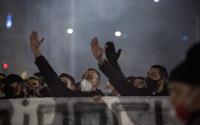11 January 2007Sujatha Fernandes
As several more leftist leaders were elected or re-elected during recent elections in Latin America, what kinds of changes have there been in their campaigns? On December 3, radical leftist president Hugo Chávez was reelected in Venezuela with 62 percent of the vote for another six-year term. Both Chávez and opposition candidate Manuel Rosales ran high profile campaigns, with publicized events, inaugurations, and public appearances. But the recent elections also reflected a shift that is taking place across Latin America, from national elections as a savvy marketing event to a forum where real issues can be brought up. Chávez continued to raise the need for regional integration and redistribution as crucial pillars of the Bolivarian project. This use of elections as a forum to put forth an alternative development model to neoliberalism has also been seen in the case of Ecuador, with the election of leftist candidate Rafael Correa.
Over the last few decades, neoliberal policies of privatization, deregulation, and dismantling of the welfare state have been hegemonic in Latin America. The mid-1980s debt crisis and subsequent structural adjustment reforms across Latin America weakened traditional political parties and labor unions. During the 1990s, this void was filled by a new breed of neo-populist politicians such as Bolivia’s Gonzalo Sanchez de Lozada (“Goni”), Venezuela’s Carlos Andrés Pérez, and Argentina’s Carlos Menem, who carried out free-market policies and built ties to Washington. Some of these leaders such as Pérez and Menem hailed from former union-based populist parties such as Democratic Action (Acción Democratica, AD) and the Peronist Party.
Neoliberal politicians orchestrated their election campaigns like cinematic spectacles. During his 1988 campaign, Pérez traveled through Venezuelan cities in a motorcade, promising to bring back the prosperity over which he presided in earlier eras. The use of his 1973 slogan, “this man really walks,” and a new slogan “these hands you see belong to Carlos Andrés,” presented him as the man who could bring back the good old days. After presiding over a “miracle” in the early 1990s following aggressive shock therapy in Argentina, Menem faced catastrophic economic collapse. When he ran for re-election in 1995, Menem’s campaign utilized images of wealth and glamour associated with a nostalgic past that only he could bring back to Argentina.
But by the new millennium, the promise and hope of an economic miracle had been lost amidst massive unemployment, growing poverty, and deepening inequalities across Latin America. The commercial strategies employed in election campaigns had to be adapted to reflect the new realities of the region. The 2002 Bolivian elections were a case in point. The film Our Brand is Crisis, reveals how conservative candidate Goni called in the American political consulting firm Greenberg Carville Shrum (GCS) to apply a market-based approach to his campaign strategy during these elections. The team promoted Goni as a product, using focus groups and negative smear campaigns to sell their product to a highly skeptical population. In their framing of the campaign, the teams agreed on “crisis” as their brand, and they marketed a shock therapy approach as the only way to resolve that crisis.
By contrast, the gradual emergence of so-called “Pink Tide” leaders has seen divergences in strategies between neoliberal conservative candidates employing this market-based approach and left-leaning candidates who seek to put real social issues on the table. In addition to Chávez who was first elected in 1998, Lula Inacio da Silva, a union organizer in Sao Paulo, and Evo Morales, a leader of the coca leaf-grower’s union, were elected in 2003 and 2005 respectively on the basis of alternative social agendas.
The recent Venezuela election demonstrated again these distinct approaches within Latin American politics. Chávez continued to promote his social programs such as the health and education missions, soup kitchens, and cooperatives, that redistribute oil wealth into the hands of organized community groups. By contrast, Manuel Rosales proposed the idea of a debit card, “Mi Negra” (My Black One), that would supposedly give poor Venezuelans direct access to government oil revenues, while maintaining neoliberal policies of privatization, deregulation, and the dismantling of social services. Rosales’ concept of “Mi Negra,” was a neo-populist strategy that treated poor Venezuelans as voters/consumers whose vote could be bought for a price. The card was intended to disburse about $US 350 per month to selected recipients, with some 40 percent of that total allocated for the purchase of food. Like other targeted poverty reduction plans in Peru, Mexico, and Brazil, the “Mi Negra” plan treated poverty as an individual problem, that could be resolved on an individual rather than social basis.
Moreover, the name “Mi Negra,” was Rosales’ attempt to woo the large black and mixed-race majority, in whose eyes the opposition is largely identified with the white and wealthy upper classes. Opposition ideologues claimed that the name comes from the color of crude oil. But Rosales employed a black Venezuelan woman to accompany him on his campaign rounds as he promoted the idea of “Mi Negra,” showing that the name has distinctly racial overtones. This was a tokenistic gesture on the part of an opposition largely out of touch with ordinary people, and it also reinforced stereotypes about black people being dependent on handouts from the government.
Even before the results of the elections were out, polls by the Venezuelan daily newspaper El Nacional in 2006 showed that about 59 percent of the population rejected the “Mi Negra” proposal. But the resounding electoral defeat of Rosales, who received 38 percent of the vote compared to Chávez’s 62 percent, clearly demonstrated the unpopularity of the neopopulist approach among a population who wants money going towards creating employment, health and welfare services, and education.
The results of the Venezuela elections seemed to replicate those of the November 26 elections in Ecuador, where leftist candidate Rafael Correa took 65 percent of the vote over conservative candidate Alvaro Noboa who received 35 percent. Like Chávez, Correa ran his campaign on an open platform of opposition to neoliberalism and US hegemony. Correa spoke of the need for Ecuador to cut its ties with the World Bank and the International Monetary Fund, and he also proposed to hold a referendum to rewrite the constitution, as took place in Venezuela after Chávez was elected in 1998. Correa pledged to break the lease of the Manta air base to the US for its anti-drug operations, and to increase the royalties extracted from foreign oil companies, similar to Morales’ actions in Bolivia. Like Chávez, Correa clearly differentiated himself from his rival candidate by outlining an alternative path of development to the neoliberal model.
Daniel Ortega, leftist leader of the Sandinista National Liberation Front (FSLN), was also recently elected in Nicaragua on November 5 with a more narrow 38 percent of the votes. Unlike Chávez and Correa, Ortega tried to appeal to both business sectors and free-trade advocates, while also highlighting his revolutionary background and opposition to US hegemony. His more moderate approach puts him closer to Brazil’s Lula, Argentina’s Kirchner, and Chile’s Bachelet in the political spectrum. But nevertheless, his victory came even despite direct intervention by US ambassador Paul Trivelli and threats by US Congressmen to pull out loans and remittances if Ortega was elected.
For the overall balance sheet at the end of 2006, leftist leaders of the pink tide have emerged in an even stronger position than before, with the exception of a few losses in Mexico and Peru to conservative candidates. Electoral successes are being strengthened by growing regional, but also global ties. In November, the Iberoamerica summit, hosted by Uruguay, brought together twenty-two Ibero-American countries, including Spain and Portugal, to discuss issues of migration and development. The countries signed the “Montevideo Commitment,” which contains statements against the criminalization of immigrants and a critique of the US proposal to build a fence along its border with Mexico. Emerging south-south strategic alliances, such as Brazil-South Africa-India ties and Cuba-Venezuela ties, are a concrete alternative to the free trade agreements that Washington was peddling in Latin America over the last decade.
But the presence of these left-leaning leaders means little without mobilization and support from the grass roots to ensure that they carry out their campaign promises. While recent elections have allowed leftist candidates to put alternative proposals on the agenda, once elected they must still work within the framework of a bourgeois state apparatus. This fact was recognized by the Zapatistas in the July elections in Mexico, as they did not campaign for leftist leader Manuel López Obrador, but rather sought to highlight the weaknesses of the electoral system. In order to carry out more radical and far-reaching changes leftist leaders must be prepared to allow popular input and participation in decision-making, with grass roots mobilizations and local popular assemblies. If these presidents renege on their promises, or shut out popular sectors, they may find themselves being ousted by popular movements, as took place with former Ecuadorian president Lucio Gutierrez in April 2005.
The death on December 11 of former Chilean dictator Agosto Pinochet, one of the chief architects of neoliberal economic reforms, is a fitting close to an era of unbridled optimism over free market economics in the region. It still remains to be seen if and how successes in the electoral arena will translate into broader changes in society, but the recent elections at least showed that the building of a counter-hegemonic alternative will surely be on the agenda for this coming year.
http://www.zmag.org/content/showarticle.cfm?SectionID=20&ItemID=11841






